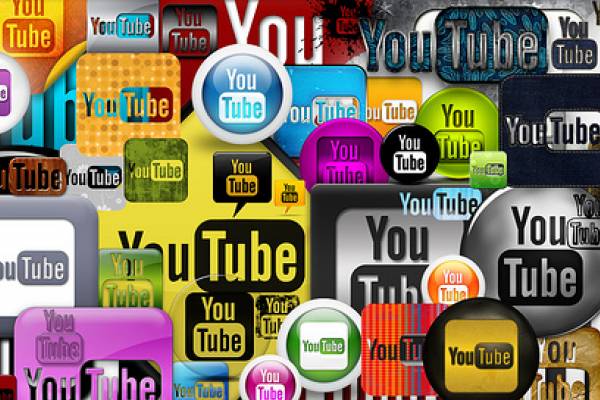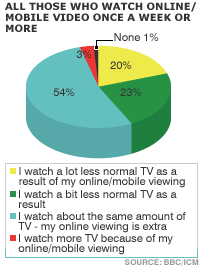Say Goodbye to TV - The YouTube Model is King
I saw a fascinating (maybe even shocking) statistic today, one that I think marks an important step on the journey towards the end of TV as we know it. Yesterday was YouTube’s sixth birthday, and to celebrate, YouTube posted on their blog that they now upload 48 hours of video every minute, and log an average of 3 billion views a day. Those astronomical figures signal a number of important changes in the way we consume media. I think we’d better brace for all-out dwindling of the TV model and the full-fledged conversion to YouTube and similar sites as our destination for all our video content.
Today on Professionally Incoherent, I’m going to dig into what this means for both the way we watch our favourite content, and more importantly, what we watch.
I’ve been toying with this issue for a few weeks, but I was unsure until today about which side to take. I couldn’t decide whether online video would be able to stage a complete takeover of TV, or whether they’d remain at an impasse in terms of viewer share. I thought that TV might remain the destination for longer-form, full-season shows, and online would be the place for shorter videos and on-demand downloads.
Not so. Given the sheer amount of stuff being put on YouTube alone, it seems like TV simply won’t be able to keep up. If you do some quick math, the current rate of video uploading on YouTube works out to 69,120 hours of new content per day. That is literally 7.8 years of video (yup!) every 24 hours. Now, obviously not all that content is being watched. There’s actually a blog-style list of strange, amateur YouTube videos with almost no views – which are likely only a selection of thousands of similar videos with no audience. But a significant portion is reaching people, and those people are watching that content instead of a TV broadcast.
And why not? If you were to abandon TV entirely in favour of YouTube, there would be some immediate advantages. There are very few full-on ads (even though more and more channels are agreeing to 30-second spots running before the video). You can pick what you want to watch, when you want it, and build playlists to watch later. On May 9th, YouTube launched their Movies service, allowing users to rent full-length films as they do on Netflix. One of my favourite features, the subscription service, updates you when the people you follow post new videos. Beyond all that is the huge selection of material available – there are entire genres that don’t exist on TV, made by legions of talented people who might not have found an audience before YouTube.
With all these extra features, why would anyone stick with TV? You have to cope with constant ads, competing schedules, episode cliffhangers. None of it is tailored to the viewer. But people put up with it because TV is still the most foolproof place to find new episodes of “big” shows you like, whether it’s well-produced new series like HBO’s Game of Thrones or guilty pleasures (a.k.a. unfiltered garbage) like MTV’s Jersey Shore. You can mess around with torrents or free downloads, but if you want the get the content the night it airs without worries of viruses or concerns of stealing, then TV is still the destination.
But we all know that more and more programs are ending up on YouTube. Sometimes episodes are uploaded illegally and promptly taken down, but others are intentionally posted by the studios. Why would they do this, considering they have a guaranteed home on TV sets everywhere? It’s because they know how many eyeballs are migrating to sites like YouTube.
Much as we’d like to be able to watch YouTube videos and TV at the same time, we can’t. We can only devote our attention to one video at a time, and until we evolve multiple heads, we’ll always have to decide how much time we spend watching YouTube and how much we spend watching TV. What’s more, it looks like YouTube is grabbing an increasing amount of people’s lives – what recreational time they used to spend on TV is now invested in YouTube.
For that reason, I think TV will eventually disappear. Maybe not tomorrow, maybe not in ten years, but it will make the full jump to online sometime. As much as YouTube is grabbing former TV couch potatoes, though, TV networks would not simply turn into YouTube channels. Companies like CBS, Fox, ABC, etc., would likely transfer all their content exclusively to their websites. In this way, the Internet would go from being competition for TV to being how TV is transmitted. Unlike now, where we still have radio waves, TV signals, and Internet connections, I think everything will relocate permanently online (radio is pretty much already there), giving the power entirely to the consumer.
This prediction is also partially confirmed by the increasing availability of Internet-capable TVs. When your YouTube videos (and future online TV broadcasts) can move from a compact laptop to the big screens we keep in our living rooms, we have yet another reason to take in all these thousands of hours of video being uploaded every day to YouTube. Once enough households own Internet TVs, YouTube will cease to be merely an informal Internet destination (if it hasn’t already) and move up to the “big leagues” of mass-market entertainment.
TV will have to adapt, or die. We no longer want to tune in at a specific time to see a show. We media consumers are terribly spoiled, and if the metaphoric TV network parents can’t satisfy our needs, we’ll point our eyeballs elsewhere.
What do you think about the coming death of TV? Excited for the technological revolution? Worried your favourite content might disappear? Don’t think it will happen? Let me know in the comments!
Check out my other articles on the state of media and Internet culture:
Internet should be a human right
Tabbed browsing and the fragmentation of our attention spans







